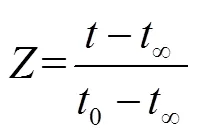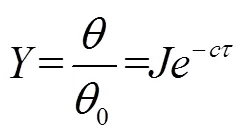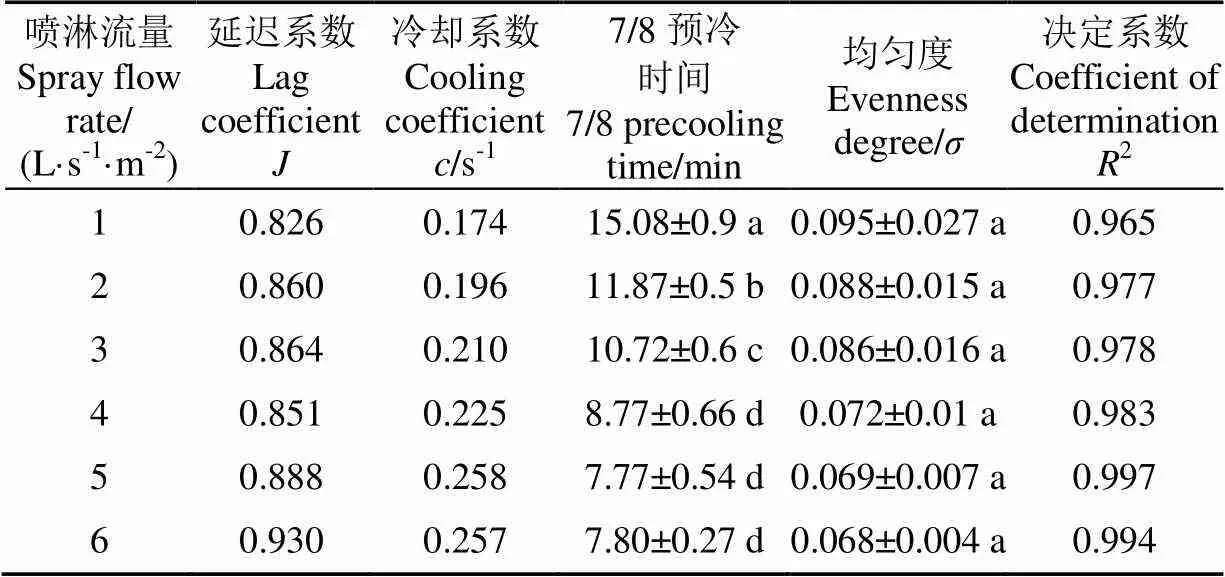喷淋预冷工艺参数对荔枝降温特性的影响
2019-01-14吕恩利陈明林刘妍华郭嘉明虞新新李鹏飞
吕恩利,陈明林,刘妍华,郭嘉明,黄 浩,虞新新,李鹏飞
喷淋预冷工艺参数对荔枝降温特性的影响
吕恩利1,陈明林1,刘妍华2※,郭嘉明1,黄 浩1,虞新新1,李鹏飞1
(1. 华南农业大学工程学院,广州 510642;2. 华南农业大学工程基础教学与训练中心,广州 510642)
为掌握喷淋预冷工艺参数对荔枝降温特性的影响,搭建了荔枝喷淋预冷试验平台,以“淮枝”荔枝为试验材料,研究了喷淋温度和喷淋流量对单层荔枝果实以及多层荔枝果实喷淋预冷降温特性的影响。试验结果表明:单层荔枝预冷,喷淋温度越低,冷却系数越大,7/8预冷时间越短,果实温度均匀性越差,选择(5±0.5)℃,能够保持较好预冷均匀性和较快的预冷速度;喷淋流量增大,冷却系数先增大后趋于稳定,7/8预冷时间先缩短后趋于平缓,与喷淋流量呈二次函数关系,果实温度均匀性提高,临界喷淋流量为5.9 L/(s·m2);多层荔枝堆叠时,果实离喷头越近,冷却系数越大,7/8预冷时间越短,果实温度均匀性越好,相对预冷时间与层数呈二次函数关系,临界预冷层数为4;研究结果为荔枝喷淋预冷装置的设计及单层与多层荔枝预冷应用提供参考。
果实;温度;流量;荔枝;喷淋预冷;降温特性
0 引 言
荔枝是岭南特色水果,具有较高的经济价值,其采收于高温多湿的季节,采后携带大量田间热[1]。预冷能使果蔬快速冷却,释放田间热,降低酶与微生物的活性,延长保鲜时间,是农产品冷链物流的重要环节[2-6]。冷水预冷是荔枝较优的预冷方式[7-8],喷淋预冷是冷水预冷的一种方法[9-10];其主要原理是将冷水喷淋到果蔬表面,使果蔬与冷水发生热量交换,具有效率高、操作方便等优点[11-12]。但荔枝预冷效果受喷淋流量、冷水温度、荔枝数量等参数的影响,需明确预冷工艺参数对荔枝喷淋预冷降温特性的影响,以优化荔枝喷淋预冷技术与装备,保障荔枝采后品质。
针对冷水预冷的研究多集中在浸泡预冷,Liang等[13]研究了浸泡预冷方式下,预冷延迟时间对荔枝贮藏品质的影响;Clément等[14]分别研究了喷淋和浸泡预冷2种方式下,甜玉米的不同摆放方式对预冷时间和贮藏品质的影响;Bárbara等[15]研究了浸泡预冷方式下,不同形状大小的果蔬与冷却速率之间的关系;吕盛坪等[16]研究了冷水、冷库和差压预冷荔枝果肉的降温规律和温度差异性;Elansari等[17]研究了喷淋预冷方式下,不同尺寸和不同温度椰枣的冷却速率。然而,针对不同喷淋流量、喷淋温度等参数下荔枝降温特性以及多层荔枝喷淋预冷降温特性的研究暂未发现报道。
为此,本文搭建荔枝喷淋预冷试验平台,研究了喷淋温度、喷淋流量对荔枝果实降温效果的影响,以及多层荔枝降温特性。以期为荔枝喷淋预冷技术与装备的优化提供参考。
1 试验装置及方法
1.1 试验装置
荔枝喷淋预冷试验平台如图1所示。蓄冷箱体采用1.5 mm厚不锈钢和8 cm厚聚乙烯隔热材料制成,箱体尺寸(长×宽×高)为1.86 m×1.01 m×1.08 m,蓄冷箱体与制冷机组(包括蒸发器、2个2匹压缩机、冷凝器等组成)相连。冷水在变频泵的抽吸作用下经喷头喷淋在荔枝表面并最终流回蓄冷箱体,形成一个循环,喷淋流量可通过改变变频泵的压力调节,安全阀可紧急控制喷头的开停。变频泵型号为DY/SD-750由江苏威乐科技有限公司生产,可调压力范围为0~0.4 MPa,最大流量为4 m3/h。喷淋流量由山东信准电子科技有限公司生产US211M智能数显流量计测定,准确度为±5%。荔枝平铺于孔质筐中,置于喷头正下方0.1 m处,喷头尺寸(长×宽)为0.3 m× 0.3 m,开256个直径为3.9 mm的小孔。孔质筐尺寸(长×宽×高)为0.3 m×0.3 m× 0.15 m,荔枝果肉温度由德国贺利氏产铂电阻PT100测得,量程为−60~300℃,精度为±0.15 ℃。

1.变频泵 2.卸压阀 3.数显流量计 4.喷头 5.孔质筐 6.荔枝 7.蒸发盘管 8.蓄冷箱体 9.压缩机 10.冷凝器
1.2 试验材料
试验用荔枝品种为“淮枝”,清晨采摘于广州从化果园,成熟度为8~9成熟。采摘后3 h内运回用于试验,挑选直径在30~32 mm间,规则无损伤荔枝为试验材料。
1.3 试验方法
在喷淋预冷试验平台上,改变冷水温度、喷淋流量,用冷却系数、7/8预冷时间和预冷均匀性来评价其对荔枝预冷降温过程的影响。喷淋温度的试验水平选取为:(2±0.5)、(5±0.5)和(9±0.5)℃,喷淋流量的试验水平选取为:1、2、3、4、5和6 L/(s·m2)。
将挑选好的荔枝平铺一层于孔质筐,将温度传感器,插入荔枝果肉,荔枝果实摆放与温度测点分布如图2a所示,其中深色位置为测点荔枝,以各点平均温度表征荔枝果实温度;通过制冷机组调节和维持喷淋温度,通过改变变频泵的压力调节喷淋流量。

注:深色位置放置被测量荔枝,温度传感器插入荔枝果肉。
为进一步分析多层荔枝堆叠预冷的降温特性,将挑选好的荔枝平铺5层于孔质筐,靠近喷头的为第一层,依次往下为第二、三、四、五层,如图1所示;每层布置3个温度传感器,插于荔枝果肉,荔枝果实摆放与温度测点分布如图2b所示,以各点平均温度表征荔枝果肉温度。采用40路数据采集仪采集传感器温度,每1 s采集数据一次,并记录。
2 评价指标
2.1 7/8预冷时间
在预冷过程中物体与周围流体的温差逐渐缩小,对流换热逐渐减缓;物体要达到周围流体的温度需要无限长的时间[17],因此,农产品预冷常用7/8预冷时间来衡量冷却效果和速率,以避免流体温度影响[18]。7/8预冷时间指荔枝温度与冷水温度的差值为荔枝初始温度与冷水温度差值的1/8时所对应的冷却时间[19]。本文将7/8预冷时间作为预冷结束的标准,计算式[20-21]为

式中为无量纲数,取1/8;为任意时刻荔枝果实温度,℃;t为喷淋温度,℃;0为荔枝果实初始温度,℃。
2.2 冷却系数
荔枝预冷过程中,过余温度比与时间的关系曲线斜率的绝对值被定义为冷却系数[22-23],直线倾斜程度越大表示冷却速率越快。荔枝的预冷过程,可用方程[17,24]表示为



式中为过余温度比;为任意时刻荔枝过余温度[25],℃;0为初始过余温度,℃;为冷却延迟系数,半对数图线的截距[17];为冷却系数,s-1;为时间,s。
2.3 均匀性
预冷均匀性指预冷过程中不同位置果实温度的差异性,预冷均匀性差,易导致荔枝出现冷害或预冷不完全,它是预冷效果的重要评价指标[26]。采用均匀度评价,其计算式为[27]


值能有效反应果品温度的不均匀性,其取值越小,表明荔枝果实中心温度离散程度越小,温度分布越均匀。
3 结果与分析
3.1 喷淋温度对单层荔枝喷淋预冷效果的影响
当喷淋流量为5 L/(s·m2)时,喷淋温度分别为(2±0.5),(5±0.5)和(9±0.5)℃条件下,对单层荔枝果实进行预冷,荔枝果实初始温度分别为26.3、25.8、26.4 ℃,记录荔枝果实温度变化。
图3a可知,喷淋温度越低,荔枝果实温度下降越快,荔枝果实终温越低。当喷淋温度一定时,预冷前期,荔枝果实温度呈急剧下降趋势,预冷后期,荔枝果实温度变化缓慢,直至恒定。预冷至15 min时,喷淋温度为(2±0.5)、(5±0.5)、(9±0.5)℃的荔枝果实温度分别为2.92、5.82、10.28℃。由此可见,降低喷淋温度,有利于缩短预冷时间,提高预冷效率[28]。
图3b所示为过余温度比与预冷时间的关系,按式(2)对不同喷淋温度的试验数据进行拟合,拟合结果如表1所示;由表可知,喷淋温度为(2±0.5)、(5±0.5)、(9±0.5)℃按式(2)拟合的降温特性曲线决定系数2分别为0.987、0.995、0.981。从图3b可知,在半对数图中拟合曲线接近直线,直线斜率的绝对值为冷却系数,截距为延迟系数[17]。喷淋温度为(2±0.5)、(5±0.5)、(9±0.5)℃时,延迟系数均小于1,即荔枝果实对外部温度变化做出的响应是滞后的[29],这主要是因为荔枝果实存在热阻作用。

注:喷淋流量为5 L·(s-1·m-2),单层荔枝。
表1为不同喷淋温度条件下,荔枝果实到达7/8预冷时间时的评价参数。从表可知,冷却系数随喷淋温度的降低呈增大趋势;喷淋温度越低,7/8预冷时间越短[30],喷淋温度为(5±0.5)℃时7/8预冷时间相对于(9±0.5) ℃变化显著(<0.05),缩短了36.3%,喷淋温度为(2±0.5) ℃时7/8预冷时间相对于(5±0.5)℃变化不明显(>0.05),缩短了15.3%,随着喷淋温度的降低7/8预冷时间缩短减缓;喷淋温度越低,果实温度均匀性越差,喷淋温度为(2±0.5)℃时果实均匀度相对于(5±0.5) ℃增大了230.4%,预冷均匀性明显变差(<0.05),通过降低喷淋温度来达到快速预冷有一定限度。因此,喷淋温度可选择(5±0.5)℃,能够保持较好预冷均匀性和较快的预冷速度。

表1 不同喷淋温度荔枝预冷结束时评价参数
注:同一列同一评价参数不同字母代表3种喷淋温度7/8预冷时间、均匀度分别在<0.05水平上差异显著,下同。
Note: Different letters within a column for the same evaluation parameter indicates significant differences at<0.05 level among three different spray temperatures, the same below.
3.2 喷淋流量对单层荔枝喷淋预冷效果的影响
当喷淋温度为(5±0.5)℃时,喷淋流量分别为1、2、3、4、5和6 L/(s·m2)的条件下,对单层荔枝果实进行预冷,记录荔枝果实温度变化。
从图4a可知,喷淋流量越大,荔枝果实温度下降越快,荔枝果实预冷终温越低。预冷至15 min时,喷淋流量为1、2、3、4、5和6 L/(s·m2)对应的荔枝果实温度依次为7.79、7.49、7.09、6.33、5.82和5.96 ℃。

注:图4a中15 min时图中线条代表喷淋流量从上至下依次为1、2、3、4、5、6 L·(s-1·m-2), 喷淋温度为(5±0.5)℃,单层荔枝。
表2为不同喷淋流量条件下荔枝果实预冷结束时各评价参数。从表可知,喷淋流量越大,冷却系数先增加后稳定;7/8预冷时间先缩短后趋于平缓,喷淋流量为5 L/(s·m2)的7/8预冷时间相较1 L/(s·m2)减少了7.31 min,增加喷淋流量能显著缩短预冷时间;荔枝果实温度均匀性变化不明显(>0.05),均匀度在0.095~0.068范围内先减小后趋于稳定。当喷淋流量达到5 L/(s·m2)后,荔枝果实冷却系数、7/8预冷时间和均匀度均趋于稳定,可能原因是荔枝果实与冷水的接触面积随着喷淋流量的增加变化减缓。因此,适宜的喷淋流量能增加预冷效率,提高果实温度均匀性。

表2 不同喷淋流量荔枝预冷结束时评价参数
为研究喷淋预冷较优喷淋流量,通过7/8预冷时间与喷淋流量的关系寻找临界流量值,当喷淋流量大于临界值时,荔枝果实与冷水的接触面积随着喷淋流量的增加变化缓慢。将7/8预冷时间与喷淋流量的关系进行非线性回归,回归曲线如图4b,7/8预冷时间与喷淋流量呈二次函数关系,回归方程为=0.32−3.547+18.2,决定系数2=0.989,这类曲线在顶点处变化率为零,可用顶点处对应的喷淋流量值估算7/8预冷时间随喷淋流量减缓的临界喷淋流量[16]。根据回归方程,求出该曲线顶点所对应的喷淋流量值,即为基于7/8预冷时间的临界喷淋流量。经过计算,得出试验条件下的临界喷淋流量为5.9 L/(s·m2),即当喷淋流量大于5.9 L/(s·m2)时,随着喷淋流量的增加,7/8预冷时间变化缓慢。因此,喷淋流量可选择5.9 L/(s·m2),若喷淋流量继续增大,不但预冷效率提升缓慢,泵的能耗也增大。
3.3 多层荔枝堆叠对喷淋预冷效果的影响
当喷淋温度为(5±0.5)℃,喷淋流量为5.9 L/(s·m2),在孔质筐内平铺5层荔枝,对其预冷,记录各层荔枝果实温度变化。
从图5a可知,上层荔枝果实温度较下层荔枝果实温度降温更快,即上层荔枝果实降温曲线更靠近荔枝果实温度轴;预冷后期上层荔枝果实温度较下层荔枝果实温度更低,即预冷后期上层荔枝果实降温曲线更靠近预冷时间轴,预冷至15 min时,第一至第五层的荔枝果实温度分别为6.27、6.50、7.03、6.93和7.80 ℃。
5层荔枝预冷结束时,中部纵截面上荔枝果实温度分布如图5b所示。从图可知,荔枝果实上层温度低,下层温度高,同层之间中间温度略高于两边。中部纵截面上,荔枝果实均匀度为0.14,各点平均温度为7.15 ℃,预冷耗时14.02 min。由此可见,多层荔枝堆叠放置时各层降温速率不一致,预冷时间较长,预冷终温不协调。
表3为各层荔枝分别到达7/8预冷时间时各评价参数。由表可知,荔枝果实第一层至第五层冷却系数逐渐减小;7/8预冷时间逐渐增大;预冷均匀性逐渐变差,且第五层显著变大(<0.05),均匀度为0.213,相较第四层增大了63%。这是因为,喷淋预冷过程中,冷水依次从第一层至第五层通过荔枝果实间隙流下,并与荔枝果实进行热交换,温度逐渐升高,所以上层荔枝果实较下层有更快的预冷速率;且由于荔枝果实间隙分布不均,导致冷水与下层荔枝果实接触不均,荔枝果实温度均匀性逐渐变差。因此,适宜的预冷层数有利于保证较好的预冷效果。

图5 多层荔枝堆叠果实降温过程与预冷结束时中部纵截面温度分布

表3 不同层荔枝预冷结束时评价参数
为研究喷淋预冷较优预冷层数,通过相对预冷时间与层数的关系寻找临界层数,当层数大于临界值时,预冷效率较高,相对预冷时间为7/8预冷时间/层数。将相对预冷时间与层数的关系进行非线性回归,回归曲线如图6所示,相对预冷时间与层数呈二次函数关系,回归方程为=0.5242−4.346+11.654,2=0.944。根据喷淋流量的临界值确定方法,求出该曲线顶点所对应的层数,即为基于相对预冷时间的临界层数。经计算得出试验条件下的临界层数为4.1,取临界层数为4;即当荔枝堆叠层数大于等于4时相对预冷时间随层数的变化很小;为提高预冷效率荔枝堆叠层数应大于等于4,但是随着堆叠层数的增加预冷均匀性逐渐变差,预冷不完全,荔枝层数应越小越好。综合分析,荔枝堆叠层数选4为宜,即保证了预冷效率,又保持了较好预冷均匀性。

图6 相对预冷时间与层数的关系
4 结论与讨论
搭建了荔枝喷淋预冷试验平台,研究了冷水温度、喷淋流量对单层荔枝果实以及多层荔枝果实喷淋预冷降温特性的影响,为荔枝喷淋预冷技术与装备的优化提供参考。实验结果表明:
1)单层荔枝,喷淋温度越低,冷却系数越大,7/8预冷时间越短,预冷均匀性越差,喷淋温度选择(5±0.5) ℃,能够保持较好预冷均匀性和较快的预冷速度。增大喷淋流量,冷却系数先增大后趋于稳定,7/8预冷时间先缩短后趋于稳定,与喷淋流量呈二次函数关系,预冷均匀性逐渐变好,分析可得临界喷淋流量为5.9 L/(s·m2),当喷淋流量大于5.9 L/(s·m2)时,预冷效率提升缓慢,泵的能耗增大;喷淋流量可选择5.9 L/(s·m2)。
2)采用单层荔枝筛选出的参数对多层荔枝预冷,从第一层至第五层,冷却系数逐渐降低,7/8预冷时间逐渐变长,预冷均匀性变差;相对预冷时间与层数呈二次函数关系,分析可得临界层数为4.1,堆叠层数可选择4,即保证了预冷效率,又保持了较好预冷均匀性。
荔枝喷淋预冷降温特性可能还受喷头开孔形状、开孔率大小、荔枝果实初始温度、荔枝果实大小等因素的影响,本课题组将在今后进行深入研究。
[1] 吕恩利,陆华忠,杨松夏,等. 气调运输包装方式对荔枝保鲜品质的影响[J]. 现代食品科技,2016,32(4):156-160.Lü Enli, Lu Huazhong, Yang Songxia, et al. Effects of packaging methods on fresh-keeping quality of litchi during controlled atmosphere transport[J]. Modern Food Science and Technology, 2016, 32(4): 156-160. (in Chinese with English abstract)
[2] Han Q, Gao H, Chen H, et al. Precooling and ozone treatments affects postharvest quality of black mulberry (Morus nigra) fruits[J]. Food Chemistry, 2017, 221: 1947-1953.
[3] Azam M M, Eissa A H A, Hassan A H. Monitoring of change in cantaloupe fruit quality under pre-cooling and storage treatments[J].Journal of Food Processing & Technology, 2015, 6(12): 527.
[4] 韩佳伟,赵春江,杨信廷,等. 送风风速对苹果差压预冷性能的影响[J]. 农业机械学报,2015,46(11):280-289. Han Jiawei, Zhao Chunjiang, Yang Xinting, et al. Effect of air-inflow velocity on cooling efficiency during forced-air precooling of apples[J]. Transactions of the Chinese Society for Agricultural Machinery, 2015, 46(11): 280-289. (in Chinese with English abstract)
[5] 王娟,谭金翠,王相友.风速对双孢蘑菇预冷过程的影响[J]. 农业机械学报,2013,44(10):203-208. Wang Juan, Tan Jincui, Wang Xiangyou. Effect of air velocity on pre-cooling process of agaricus bisporus[J]. Transactions of the Chinese Society for Agricultural Machinery, 2013, 44(10): 203-208. (in Chinese with English abstract)
[6] 宋晓燕,刘宝林. 真空冷却中的上海青表面温度变化规律[J]. 农业工程学报,2012,28(1):266-269. Song Xiaoyan Liu Baolin. Temperature variation on Shanghaiqing surface during vacuum cooling process[J]. Transactions of the Chinese Society of Agricultural Engineering (Transactions of the CSAE), 2012, 28(1): 266-269. (in Chinese with English abstract)
[7] 吕盛坪,吕恩利,陆华忠,等. 不同预冷方式对荔枝贮藏品质的影响[J]. 现代食品科技,2014,30(3):157-162. Lü Shengping, Lü Enli, Lu Huazhong, et al. Effect of different precooling methods on the storage quality of litchi[J]. Modern Food Science and Technology, 2014, 30(3): 157-162. (in Chinese with English abstract)
[8] 阮文琉,刘宝林,宋晓燕. 荔枝的冷却方式选择[J].食品工业科技,2012,33(11):352-353. Ruan Wenliu, Liu Baolin, Song Xiaoyan. Comparison of cooling method for litchi fruit[J]. Science and Technology of Food Industry, 2012, 33(11): 352-353. (in Chinese with English abstract)
[9] Becker B R, Fricke B A. Hydrocooling time estimation methods[J]. International Communications in Heat and Mass Transfer, 2002, 29(2): 165-174.
[10] 付艳武,高丽朴,王清,等. 蔬菜预冷技术的研究现状[J].保鲜与加工,2015,15(1):58-63. Fu Wuyan, Gao Lipu, Wang Qing, et al. Research status on precooling techniques of vegetables[J]. Storage and Process, 2015, 15(1): 58-63. (in Chinese with English abstract)
[11] Góral D, Kluza F, Kozłowicz K. Assessment of heat transfer and mass change during fruits and vegetables impingement pre-cooling[J]. International Journal of Food Engineering, 2014, 10(1): 183-189.
[12] 杨洲. 水果产后处理技术与装备[M]. 1版. 北京:中国农业出版社,2014.
[13] Liang Y S, Wongmetha O, Wu P S, et al. Influence of hydrocooling on browning and quality of litchi cultivar Feizixiao during storage[J]. International Journal of Refrigeration, 2013, 36(3): 1173-1179.
[14] Clément Vigneault, Goyette B , Yvan Gariépy, et al. Effect of ear orientations on hydrocooling performance and quality of sweet corn[J]. Postharvest Biology & Technology, 2007, 43(3): 351-357.
[15] Bárbara T, Theo K, Luis C. Cooling parameters for fruits and vegetables of different sizes in a hydrocooling system[J].Scientia Agricola, 2004, 61(6): 655-658.
[16] 吕盛坪,吕恩利,陆华忠,等. 荔枝不同预冷方式降温特性研究[J]. 华南农业大学学报,2015,36(3):114-119. Lü Shengping, Lü Enli, Lu Huazhong, et al. Cooling characteristics of different precooling methods for litchi[J]. Journal of South China Agricultural University,2015, 36(3): 114-119. (in Chinese with English abstract)
[17] Elansari A M. Hydrocooling rates of Barhee dates at the Khalal stage[J]. Postharvest Biology & Technology, 2008, 48(3): 402-407.
[18] 刘美玉,崔建云,任发政,等. 鸡蛋强制通风预冷工艺研究[J]. 农业机械学报,2010,41(8):135-139. Liu Meiyu, Cui Jianyun, Ren Fazheng, et al. Forced-air precooling conditions of eggs[J]. Transactions of the Chinese Society for Agricultural Machinery, 2010, 41(8): 135-139. (in Chinese with English abstract)
[19] 谭晶莹,杨昭. 苹果强制通风预冷试验[J]. 农业机械学报,2008,39(7):95-98. Tan Jingying, Yang Zhao. Experimental study on forced-air precooling of apples in bulk[J]. Transactions of the Chinese Society for Agricultural Machinery, 2008, 39(7): 95-98. (in Chinese with English abstract)
[20] Teruel B, Cortez L, Leal P, et al. Forced-air cooling of banana[J]. Revista Brasileira De Fruticultura, 2002, 24(1): 142-146.
[21] 王强,刘凤珍,连添达. 葡萄差压通风预冷影响参数的试验研究[J]. 农业工程学报,2006,22(4):212-215. Wang Qiang, Liu Fengzhen, Lian Tianda. Experimental study on parameters affecting grape pressure pre-cooling[J]. Transactions of the Chinese Society of Agricultural Engineering (Transactions of the CSAE), 2006, 22(4): 212-215. (in Chinese with English abstract)
[22] Anderson, B A, Sarkar A, Thompson, J F, et al. Commercial-scale forced-air cooling of packaged strawberries[J]. Transactions of the ASAE, 2004, 47(1): 183-190.
[23] Henry F E, Bennett A H. “Hydraircooling” vegetable products in unit loads[J]. Transactions of the Asae, 1973, 16(4): 731-733.
[24] Dincer I, Genceli O F. Cooling process and heat transfer parameters of cylindrical products cooled both in water and in air[J]. International Journal of Heat & Mass Transfer, 1994, 37(4): 625-633.
[25] 杨世铭,陶文铨. 传热学[M]. 4版. 北京:高等教育出版社,2006.
[26] 杨培志,胡霞,廖刚.送风温度对苹果差压预冷降温效果的影响[J].热科学与技术,2017,16(5):381-386. Yang Peizhi, Hu Xia, Liao Gang. Effect of air supply temperature on cooling efficiency for pressure precooling of apples[J]. Journal of Thermal Science and Technology, 2017, 16(5): 381-386. (in Chinese with English abstract)
[27] 郭嘉明,吕恩利,陆华忠,等. 盒装荔枝果实降温特性数值分析与验证[J]. 农业机械学报,2016,47(5):218-224. Guo Jiaming, Lü Enli, Lu Huazhong, et al. Numerical analysis and verification on characteristics of temperature decreasing of litchi fruits with packages[J]. Transactions of the Chinese Society for Agricultural Machinery, 2016, 47(5): 218-224. (in Chinese with English abstract)
[28] 季丽丽,梁芸志,陈存坤,等. 不同温度差压预冷及其对西葫芦冷藏效果的影响[J]. 农业工程学报,2018,34(1):287-293. Ji Lili, Liang Yunzhi, Chen Cunkun. et al. Forced-air pre-cooling of different temperatures and its effects on cold storage of Cucurbita pepo[J]. Transactions of the Chinese Society of Agricultural Engineering (Transactions of the CSAE), 2018, 34(1): 287-293. (in Chinese with English abstract)
[29] 周慧娟,叶正文,苏明申,等. 低温和差压式预冷对不同品种桃果实预冷性能的影响[J]. 保鲜与加工,2015,15(1):16-19. Zhou Huijuan, Ye Zhengwen, Su Mingshen, et al. Effects of low temperature and forced-air precooling on precooling performance of different varieties of peach fruits[J]. Storage and Process, 2015, 15(1): 16-19. (in Chinese with English abstract)
[30] 高治国,王伟锋. 不同预冷温度对番茄压差预冷效果的影响[J]. 建筑热能通风空调,2014,33(3):73-75. Gao Zhiguo, Wang Weifeng. The Influences of different precooling temperature on tomato pressure pre-cooling effects[J]. Building Energy & Environment, 2014, 33(3): 73-75. (in Chinese with English abstract)
Effects of different spray precooling parameters on cooling characteristics of litchi
Lü Enli1, Chen Minglin1, Liu Yanhua2※,Guo Jiaming1, Huang Hao1, Yu Xinxin1, Li Pengfei1
(1.,,510642,; 2.,510642,)
To investigate the effects of spray precooling parameters on the cooling characteristics of litchi fruit, a spray precooling test platform was established. “Huaizhi” litchi fruit was chosen as raw materials for this study. The effects of spray temperature and spray flow rates on the cooling coefficient, 7/8 cooling time, and cooling uniformity, as well as the characteristics of multilayer litchi spray cooling, were studied. For spray precooling of single layer litchi, the lower the spray temperature was, the bigger the cooling coefficient was, the shorter the 7/8 cooling time was, and the worse the temperature uniformity of the fruit was. When the spraying temperature was less than (5±0.5)℃, the 7/8 precooling time was shortened, and the precooling unevenness increased significantly (<0.05). The effects of spray temperature to achieve rapid precooling was limited. Therefore, a spray temperature of (5±0.5)℃ could be chosen in the actual precooling process, and it could maintain the precooling uniformity and accelerate precooling rate of litchi. With the increase of pray flow rate, the cooling coefficient initially increased and then stabilized, and the 7/8 precooling time initially shortened and then leveled gently, and the fruit temperature uniformity increased. The 7/8 precooling time had a quadratic function relationship with the spray flow rate. The 7/8 precooling time decreased slowly when the spray flow was higher than 5.9 L/(s·m2). This was because the contact area between the litchi and cold water increased more slowly than the flow rate. Therefore, the flow rate of litchi spray precooling could be selected to be 5.9 L/(s·m2), which could improve the precooling efficiency and reduce the energy consumption of the pump. When multilayer litchi fruits were stacked, the closer the spray nozzle was, the bigger the cooling coefficient was, the shorter the 7/8 precooling time was, and the better the temperature uniformity was. The relative precooling time had a quadratic function relationship with the number of layers, and the number of critical precooling layers was 4.1. When the number of litchi stacks was larger than or equal to 4, the relative precooling time varied little. To improve the precooling efficiency, the number of litchi stacks should be bigger than or equal to 4. However, as the number of layers increased, the precooling uniformity gradually deteriorated. When the multilayer litchees were stacked, the cooling rate of each layer was inconsistent, the precooling time was longer, and the precooling final temperature was not coordinated. The whole process of precooling took 14.02 minutes. After precooling, theof the middle longitudinal section was 0.14, and the average temperature was 7.15 ℃. In single layer litchi spray precooling, the spray temperature could be selected as (5±0.5)℃, and the spray flow could be selected as 5.9 L/(s·m2). The parameters of the single layer litchi spray precooling were used to precool the multilayer litchi, and the number of layers of the best stack of litchi was found to be 4. The research results provided reference for the design of litchi spray precooling equipment and single-layer and multilayer litchi precooling applications.
fruits; temperature; flow rate;litchi; spray precooling; cooling characteristics
吕恩利,陈明林,刘妍华,郭嘉明,黄 浩,虞新新,李鹏飞. 喷淋预冷工艺参数对荔枝降温特性的影响[J]. 农业工程学报,2018,34(24):292-298. doi:10.11975/j.issn.1002-6819.2018.24.035 http://www.tcsae.org
Lü Enli, Chen Minglin, Liu Yanhua, Guo Jiaming, Huang Hao, Yu Xinxin, Li Pengfei. Effects of different spray precooling parameters on cooling characteristics of litchi[J]. Transactions of the Chinese Society of Agricultural Engineering (Transactions of the CSAE), 2018, 34(24): 292-298. (in Chinese with English abstract) doi:10.11975/j.issn.1002-6819.2018.24.035 http://www.tcsae.org
2018-07-05
2018-11-19
国家重点研发计划子任务(2018YFD0701002);广东省省级(基础研究及应用研究重大)项目(2016KZDXM028);广东省科技计划项目(2017B020206005);广州市科技计划项目(201704020067);国家自然科学基金项目(51108194)
吕恩利,博士,副教授,博士生导师,主要研究方向为农产品冷链物流技术与装备。Email:enlilv@scau.edu.cn.
刘妍华,博士,副教授,主要研究方向为农产品冷链物流和农业设施节能设计。Email:cynthial@scau.edu.cn.
10.11975/j.issn.1002-6819.2018.24.035
S375; TS255.3
A
1002-6819(2018)-24-0292-07
